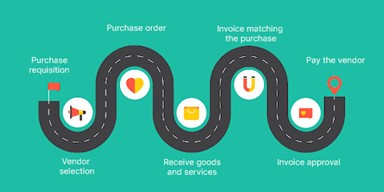7 Steps to a Perfect Process
Procurement managers know that the QAD procure-to-pay process is a critical part of managing your organizations spend. It is sometimes a challenging process because of the complex approval routings and workflows, and the involvement of myriad parties across departments.
However, a methodical procurement process can automate these complex approval routings and workflows to ensure the procurement process is efficient, accurate, and affordable.
What is the procure-to-pay process?
The definition of the procure-to-pay process is simple. P2P is a subdivision of the procurement process. It refers to software or solutions that enable the integration of the purchasing department with the accounts payable department.
Procure-to-pay is related to, but different from, the larger process of procurement, which includes sourcing goods and services, negotiating terms, ordering, ensuring accurate delivery and quality, and managing payments.
Procure-to-pay does not include the sourcing of the goods and services; nor does it include production planning or forecasting. Procure-to-pay includes the steps that can be automated with software.
7 steps in the procure-to-pay process
Every business is unique, but there are several procure-to-pay steps used frequently. Some of the most common you can see below on the procure-to-pay business process map:
- Create a purchase requisition. When an employee needs to purchase a good or service, they create a document called a purchase requisition and send it to a manager for approval. Depending on the purchase amount, the purchase requisition may require multiple approvals, and these approvals can and normally do have ‘rules’ governing the approval.
- Select a vendor. After a manager approves a purchase requisition, employees must access an approved-vendor list, more commonly with contact pricing when deciding where they’ll purchase the item(s).
- Create a purchase order. A procurement employee then creates a purchase order (PO) to send to the chosen vendor. Depending on the size and type of purchase, there may be multiple POs sent to multiple vendors.
- Receive goods and services. After the vendor(s) receive the purchase order(s), they deliver the goods or services to the purchaser. Assuming there are no issues that the vendor must address, procurement managers approve the transaction and mark the purchase order as “‘fulfilled.”
- Receive invoice matching the purchase. The vendor issues an invoice to the purchaser that includes the amount owed and the due date. The invoice will specify the goods or services provided.
- Reconcile and approve the invoice. In order to appropriately determine the status of the purchase, the vendor invoice must be reconciled with the original purchase order. When the purchaser and other managers formally indicate that they’ve received the product/service, the invoice can move on to the payment process.
- Pay the vendor. Finally, the procurement department sends the approved invoice to the accounts payable team, who schedules the payment. Typically, this results in an outgoing payment via a check, ACH, or wire transfer to the vendor’s bank account. However, there may be different payment requirements, particularly for international transactions.
Benefits of an automated procure-to-pay process
Given the numerous parties and steps involved in the procurement process, there is significant room for automation to improve workflow efficiencies, lower costs, and build better relationships with suppliers. Procure-to-pay solutions can:
- Reduced process cycle time. Approvals, requisitions, purchase orders, notifications, and payments are processes that follow basic and consistent rules. Utilizing an Approval Routing and Workflow solution will reduce friction and improve efficiency to make the procurement process much leaner and minimize the propensity for error.
- Reduce costs. In addition to making the procurement process more consistent, automation can reduce the costs associated with maintaining them. The more steps you can automate, the more man-hours can be reduced or assigned to more productive tasks.
- Improved approval visibility/tracking. By tracking each step of the purchasing and approval processes, and centralizing this data, managers have a complete picture of historical and planned purchases and expenditures.
- Strengthen relationship with vendors. By speeding up approval and payment processes through AP Automation, vendors receive purchase orders quickly and get paid on time. Everyone benefits from predictable, smooth processes.
- Negotiate with authority. Negotiations are about business leverage and access to information. Automation gives a business the flexibility to choose from a larger pool of vendors, because managing those vendors is less of a burden.
- Improved process controls. Proactively identify and improve upon existing processes within Procure-to-Pay to meet new quotas and/or standards of quality.
- Elimination of paper forms. Digital solutions have entirely improved information flow. Reducing paper improves employee productivity, increases accessibility, improves data security, and significantly reduces costs.
- Reduced auditing costs. Good internal controls can help reduce Audit Fees and increase the quality of financial reporting.
- Process standardization. Improvement of operational performance, cost reduction through decreased process errors, and facilitation of internal/external communication.
- Elimination of redundant data entry. Efficiently organize data in a database so that redundant data is eliminated. This process can ensure that all of a company’s data looks and reads similarly across all records.
Best practice: automate the procure-to-pay process
Using software to automate the procure-to-pay process will ensure that the steps are performed consistently, efficiently, and affordably. It also is a scalable solution that can enable the procurement department to manage large operations without having to increase staff to handle all the moving parts.
In traditional procurement workflows, the request and approvals steps usually are the most time-consuming and error-prone steps. Workflow automation software can help standardize request creation, define requirements that must be completed to ensure consistency and quality, quickly send and track active approvals, and designate rules about who needs to approve certain types of purchases.
Further, business procurement management software helps to centralize all of the information about ongoing and historical procurement processes so that no one has to waste time scrounging through documents or emails to understand the state of a project. This also helps to ensure that information is not lost and steps are not forgotten.
Use ISS Group to gain control, visibility, and efficiencies over QAD integrated processes
The Procure-to-pay process is just one area within QAD that ISS Group solutions can help improve the flow and control of QAD integrated Processes. Processes which require an Approval/Rejection prior to performing an Action.
ISS Group offers seamless Process Improvement and Automation solutions to organizations using the QAD ERP system to ensure continuity, efficiency, and accuracy from corporate and remote locations. Our solutions significantly enhance QAD by automating integrated processes utilizing innovative ‘Data-Driven’ Approval Routing and Workflow technology. Please contact us for a more comprehensive review and a custom demo of the best-in-class process improvement solutions for QAD ERP.





